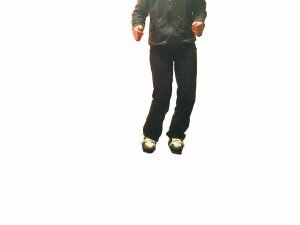 Grant Gunderson photo.
Grant Gunderson photo.All of us know at least one of those people who picked up skiing quickly, with ease and grace. Us mere mortals advance slowly, however, dedicating hours to the sport, trying to figure out the intermediate or black diamond runs without hurting ourselves. Many factors make an advanced snow athlete: genetics, environment, activities and activity level and the culture or family they grew up in, to name a few. The factor that interests me most is the development of movement patterns at a young age.
Before learning to walk, babies learn to hold up their head, side bend, twist, engage their core, sit up, slither, roll over, creep and crawl. Each baby learns these complex movements to the beat of their own drum. Some babies learn many intricate motions before they walk. Others skip some steps. Once they learn to toddle, the movements of the feet, knees, legs and hips become more refined. In the blink of an eye, they’re walking and then running, jumping, hopping and driving their parents crazy.
Have you ever watched a toddler take its first toddles? That side-to-side waddle is the precursor to walking, as they haven’t figured out how to balance on one foot as the other foot swings forward. I can still picture my son attempting to run before he mastered walking: splat! Down he went, shocked that he couldn’t run like his big brother. He hadn’t practiced or developed the intricate foot motions needed for running yet.
Just like walking, skiing requires developmental movements in different sequences and intensity levels. Some of the movement patterns need to be turned down a little, others need to be turned up. For instance, to ski an intermediate run we only need to side bend and twist a little at the waist. On a steeper run, we need to twist and side bend down the fall line to a greater degree. Observing which motions we struggle with can provide insights into why our skiing isn’t progressing. The problem is that many of us are like my son who wanted to run before he practiced the necessary movements of advanced walking… splat!
So, if you are having trouble learning to ski, your skills have plateaued, or you’re working harder than your ski buddies to get down the hill, you may be overcompensating for a movement pattern you skipped in the first years of life. The most amazing part of being human is that we are able to learn and change even as we age. It can be harder to make changes when we’re older, but learning keeps us young.
The night or morning before you go skiing try these foot exercises:
 Photos by Luca Williams.
Photos by Luca Williams.1. Lean forward and back, barefoot or in shoes without heels. Then put on your ski boots and your skis and lean forward and back in your gear. Notice how much farther you can lean in your boots and skis. Then, the day of, go out on a bunny hill and lean forward and back while skiing. Play and experiment with the forward and back motion.
2. Tilt from side to side first in bare feet, then in your boots and skis and then on the slope. Play with these motions and exaggerate them.
3. Next time you go skiing, repeat the forward and back and side-to-side motions. Experiment with all the different weight shifts you can make in your ski boots. Shift your weight in a circle, with the center of the circle being the sole of your foot. If you can easily shift your weight in a circle then you can shift your weight in any way you need to in order to ski. But if parts of the circle are difficult to access or seem more straight-edged and square, then take a deep breath and check how tight your neck, shoulder and jaw are at the points that trouble you. Start with a small circle and master that. Then try a large one. Make sure your circle consistently curves without straight sides. Keep breathing and feel the pressure shifts on the bottoms of your feet.
4. When you get back on the bunny slope notice if the pressure on the soles of your feet is different. Traverse across the slope one way, then turn around and traverse the other way. Has your ability to rock back and forth and lean from side to side improved?
By improving these movement patterns, you may find that you’ve also improved at other sports that have troubled you. For instance, I have worked with snowboarders to improve body patterns to eliminate back pain, and found that improving their movement patterns radically changed their golf game for the better. So have fun and explore the body that you were born with!
 Luca Williams is a Certified Rolfer in Glacier, Washington. She helps snowboarders, skiers, and other outdoor enthusiasts to get aligned and out of pain. Website: lucasrolfing.com blog: movingwithgravity.wordpress.com.
Luca Williams is a Certified Rolfer in Glacier, Washington. She helps snowboarders, skiers, and other outdoor enthusiasts to get aligned and out of pain. Website: lucasrolfing.com blog: movingwithgravity.wordpress.com.